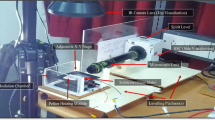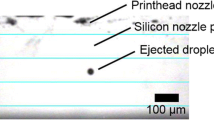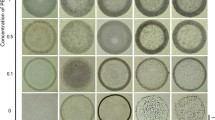Abstract
Understanding flow patterns and coupled transport phenomena during evaporation of droplets loaded with colloidal particles is central to design technical applications such as organizing proteins/DNA on a solid surface. We review recent reports on evaporating sessile droplets of colloidal suspensions on a solid surface. Starting from the classical mechanism of formation of a ring-like deposit, we discuss the influence of several problem parameters. Notably, thermal or solutal Marangoni effect, particle size, particle concentration, particle shape, substrate wettability, pH of the suspension, etc. have been found important in controlling the deposition pattern. The deposit pattern complexity and shape have been attributed to the underlying coupled transport phenomena during the evaporation. We discuss important regime maps reported for different types of deposits, which allow us to classify the deposits and coupled physics. We also present studies that have demonstrated particles sorting in an evaporating bidispersed colloidal suspension on a solid surface. Finally, some remarks for the future research opportunities in this arena are presented.

Copyright (2018) American Chemical Society.



(reprinted with permission from Ref.15, Copyright (2008) American Physical Society).

Reprinted with permission from Ref.20. Copyright (2015) Royal Society Of Chemistry.

Reprinted with permission from Ref.21, Copyright (2015) American Chemical Society.

Reprinted with permission from Ref.25. Copyright (2016) Royal Society Of Chemistry

Reprinted with permission from Ref.14. Copyright (2016) American Chemical Society.

Reprinted with permission from Ref.28. Copyright (2017) Nature Publishing Group.

Reprinted with permission from Ref.30. Copyright (2018) American Chemical Society.

Reprinted with permission from Ref.31. Copyright (2013) American Chemical Society.

Reprinted with permission from Ref.33. Copyright (2013) American Chemical Society.

Reprinted with permission from Ref.34. Copyright (2018) Elsevier.

Reprinted with permission from Ref.35. Copyright (2010) American Chemical Society.

Reprinted with permission from Ref.41. Copyright (2011) Royal Society of Chemistry.

Reprinted with permission from Ref.43. Copyright (2017) American Chemical Society.

Reprinted with permission from Ref.30. Copyright (2018) American Chemical Society.

Reprinted with permission from Ref.44. Copyright (2018) Royal Society of Chemistry.
Similar content being viewed by others
References
Larson RG (2017) In retrospect: twenty years of drying droplets. Nature 550:466
De Gans BJ, Duineveld PC, Schubert US (2004) Inkjet printing of polymers: state of the art and future developments. Adv Mater 16:203–213
Tekin E, Smith PJ, Schubert US (2008) Inkjet printing as a deposition and patterning tool for polymers and inorganic particles. Soft Matter 4:703–713
Cai Y, Zhang Newby B-M (2008) Marangoni flow-induced self-assembly of hexagonal and stripelike nanoparticle patterns. J Am Chem Soc 130:6076–6077
Wen JT, Ho C-M, Lillehoj PB (2013) Coffee ring aptasensor for rapid protein detection. Langmuir 29:8440–8446
Shiri S, Martin KF, Bird JC (2019) Surface coatings including fingerprint residues can significantly alter the size and shape of bloodstains. Forensic Sci Int 295:189–198
Deegan RD, Bakajin O, Dupont TF, Huber G, Nagel SR, Witten TA (1997) Capillary flow as the cause of ring stains from dried liquid drops. Nature 389:827–829
Bhardwaj R, Longtin JP, Attinger D (2010) Interfacial temperature measurements, high-speed visualization and finite-element simulations of droplet impact and evaporation on a solid surface. Int J Heat Mass Transf 53:3733–3744
Larson RG (2014) Transport and deposition patterns in drying sessile droplets. AIChE J 60:1538
Sefiane K (2014) Patterns from drying drops. Adv Coll Interface Sci 206:372–381
Parsa M, Harmand S, Sefiane K (2018) Mechanisms of pattern formation from dried sessile drops. Adv Coll Interface Sci 254:22–47
Picknett RG, Bexon R (1977) The evaporation of sessile or pendant drops in still air. J Colloid Interface Sci 61:336–350
Sommer AP, Ben-Moshe M, Magdassi S (2004) Self-discriminative self-assembly of nanospheres in evaporating drops. J Phys Chem B 108:8–10
Patil ND, Bange PG, Bhardwaj R, Sharma A (2016) Effects of substrate heating and wettability on evaporation dynamics and deposition patterns for a sessile water droplet containing colloidal particles. Langmuir 32:11958–11972
Maheshwari S, Zhang L, Zhu Y, Chang H-C (2008) Coupling between precipitation and contact-line dynamics: multiring stains and stick-slip motion. Phys Rev Lett 100:044503
Sangani AS, Lu C, Su K, Schwarz JA (2009) Capillary force on particles near a drop edge resting on a substrate and a criterion for contact line pinning. Phys Rev E 80:011603
Jung J-Y, Kim YW, Yoo JY, Koo J, Kang YT (2010) Forces acting on a single particle in an evaporating sessile droplet on a hydrophilic surface. Anal Chem 82:784–788
Wong T-S, Chen T-H, Shen X, Ho C-M (2011) Nanochromatography driven by the coffee ring effect. Anal Chem 83:1871–1873
Weon BM, Je JH (2013) Self-pinning by colloids confined at a contact line. Phys Rev Lett 110:028303
Li Y, Lv C, Li Z, Quéré D, Zheng Q (2015) From coffee rings to coffee eyes. Soft matter 11:4669–4673
Parsa M, Harmand S, Sefiane K, Bigerelle M, Deltombe R (2015) Effect of substrate temperature on pattern formation of nanoparticles from volatile drops. Langmuir 31:3354–3367
Hu H, Larson RG (2005) Analysis of the effects of Marangoni stresses on the microflow in an evaporating sessile droplet. Langmuir 21:3972–3980
Hu H, Larson RG (2006) Marangoni effect reverses coffee-ring depositions. J Phys Chem B 110:7090–7094
Bhardwaj R, Fang X, Attinger D (2009) Pattern formation during the evaporation of a colloidal nanoliter drop: a numerical and experimental study. New J Phys 11:075020
Zhong X, Duan F (2016) Disk to dual ring deposition transformation in evaporating nanofluid droplets from substrate cooling to heating. Phys Chem Chem Phys 18:20664–20671
Perelaer J, Smith PJ, Hendriks CE, van den Berg AM, Schubert US (2008) The preferential deposition of silica micro-particles at the boundary of inkjet printed droplets. Soft Matter 4:1072–1078
Biswas S, Gawande S, Bromberg V, Sun Y (2010) Effects of particle size and substrate surface properties on deposition dynamics of inkjet-printed colloidal drops for printable photovoltaics fabrication. J Sol Energy Eng 132:021010
Ryu S-A, Kim JY, Kim SY, Weon BM (2017) Drying-mediated patterns in colloid-polymer suspensions. Sci Rep 7:1079
Malla LK, Bhardwaj R, Neild A (2019) Analysis of profile and morphology of colloidal deposits obtained from evaporating sessile droplets. Colloids Surf A Physicochem Eng Asp 567:150–160
Patil ND, Bhardwaj R, Sharma A (2018) Self-Sorting of bidispersed colloidal particles near contact line of an evaporating sessile droplet. Langmuir 34:12058–12070
Nguyen TA, Hampton MA, Nguyen AV (2013) Evaporation of nanoparticle droplets on smooth hydrophobic surfaces: the inner coffee ring deposits. J Phys Chem C 117:4707–4716
Orejon D, Sefiane K, Shanahan ME (2011) Stick–slip of evaporating droplets: substrate hydrophobicity and nanoparticle concentration. Langmuir 27:12834–12843
Li Y-F, Sheng Y-J, Tsao H-K (2013) Evaporation stains: suppressing the coffee-ring effect by contact angle hysteresis. Langmuir 29:7802–7811
Bhardwaj R (2018) Analysis of an evaporating sessile droplet on a non-wetted surface. Colloid Interface Sci Commun 24:49–53
Bhardwaj R, Fang X, Somasundaran P, Attinger D (2010) Self-assembly of colloidal particles from evaporating droplets: role of DLVO interactions and proposition of a phase diagram. Langmuir 26:7833–7842
Still T, Yunker PJ, Yodh AG (2012) Surfactant-induced Marangoni eddies alter the coffee-rings of evaporating colloidal drops. Langmuir 28:4984–4988
Marin A, Liepelt R, Rossi M, Kähler CJ (2016) Surfactant-driven flow transitions in evaporating droplets. Soft Matter 12:1593–1600
Yunker PJ, Still T, Lohr MA, Yodh A (2011) Suppression of the coffee-ring effect by shape-dependent capillary interactions. Nature 476:308–311
Dugyala VR, Basavaraj MG (2014) Control over coffee-ring formation in evaporating liquid drops containing ellipsoids. Langmuir 30:8680–8686
Han W, Byun M, Lin Z (2011) Assembling and positioning latex nanoparticles via controlled evaporative self-assembly. J Mater Chem 21:16968–16972
Chhasatia VH, Sun Y (2011) Interaction of bi-dispersed particles with contact line in an evaporating colloidal drop. Soft Matter 7:10135–10143
Monteux CC, Lequeux FO (2011) Packing and sorting colloids at the contact line of a drying drop. Langmuir 27:2917–2922
Parsa M, Harmand S, Sefiane K, Bigerelle M, Deltombe R (2017) Effect of substrate temperature on pattern formation of bidispersed particles from volatile drops. J Phys Chem B 121:11002–11017
Iqbal R, Majhy B, Shen AQ, Sen A (2018) Evaporation and morphological patterns of bi-dispersed colloidal droplets on hydrophilic and hydrophobic surfaces. Soft Matter 14:9901–9909
Attinger D, Moore C, Donaldson A, Jafari A, Stone HA (2013) Fluid dynamics topics in bloodstain pattern analysis: comparative review and research opportunities. Forensic Sci Int 231:375–396
Brutin D, Sobac B, Loquet B, Sampol J (2011) Pattern formation in drying drops of blood. J Fluid Mech 667:85–95
Hurth C, Bhardwaj R, Andalib S, Frankiewicz C, Dobos A, Attinger D et al (2015) Biomolecular interactions control the shape of stains from drying droplets of complex fluids. Chem Eng Sci 137:398–403
Acknowledgements
RB gratefully acknowledges financial support by a Grant (EMR/2016/006326) from the Science and Engineering Research Board (SERB), Department of Science and Technology (DST), New Delhi, India.
Author information
Authors and Affiliations
Corresponding authors
Additional information
Publisher's Note
Springer Nature remains neutral with regard to jurisdictional claims in published maps and institutional affiliations.
Rights and permissions
About this article
Cite this article
Patil, N.D., Bhardwaj, R. Recent Developments on Colloidal Deposits Obtained by Evaporation of Sessile Droplets on a Solid Surface. J Indian Inst Sci 99, 143–156 (2019). https://doi.org/10.1007/s41745-019-0105-9
Received:
Accepted:
Published:
Issue Date:
DOI: https://doi.org/10.1007/s41745-019-0105-9




